Mayan Maize God And Ancient City Of El Mirador
David Tee - AncientPages.com - Deep in the heart of the Guatemalan jungle lies a little forgotten city.
It is called today El Mirador, and in its heyday, it could be seen as a vital Mayan city.
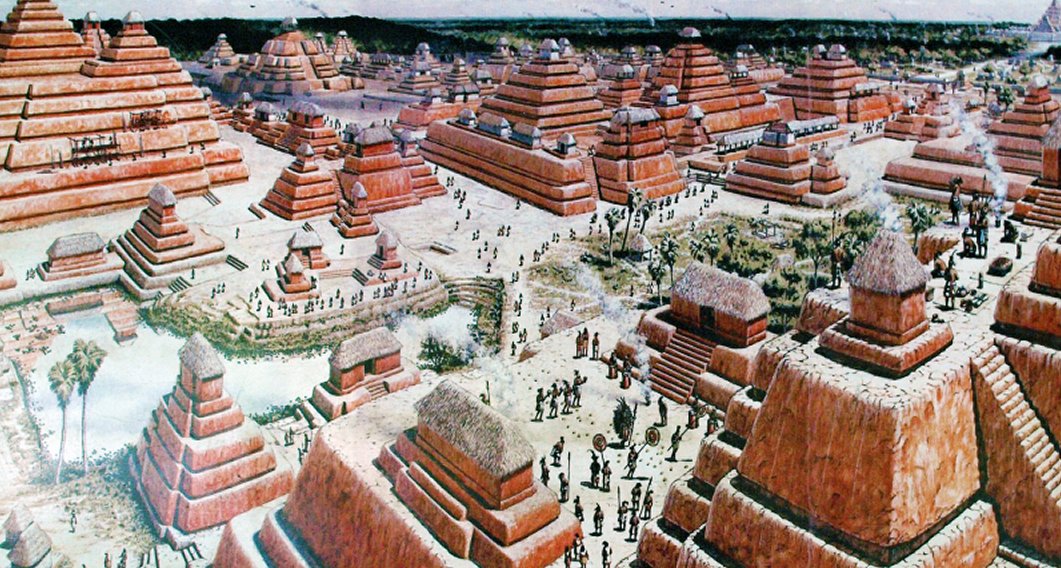 El Mirador, Guatemala. source
El Mirador, Guatemala. source
Like other Mayan cities of that time, El Mirador was home to many Mayan gods, including the Maize god.
One of its claims to modern fame is that El Mirador is a pre-Classic Mayan city larger than many of its successors. Before it became extinct, though, the inhabitants built three pyramids within its borders.0
The largest, La Danta, used some 99 cubic feet of rock and filler material to reach its large size. It is unknown whether this was the temple of the Maize god, but since it had steps, it may have been used for human sacrifices.
The pyramids without steps were buildings that were not to be entered or touched. It is quite possible that there was a temple to the Maize god in this lost city, but records are lost, and now, nothing can be determined by archaeological excavation.
Maize God And The Young Baby Jaguar
Mayan myths are only sometimes easy to decipher as their stories change over time. The history of the Maize god can first be found in the Popol Vuh. This original myth has the Maize god being born, dying, and resurrected from the Mayan underworld.
His birth is well known and came from an illicit affair between the God N and the Wayaab. The affair was discovered when the young baby jaguar was presented to the Lady’s husband.
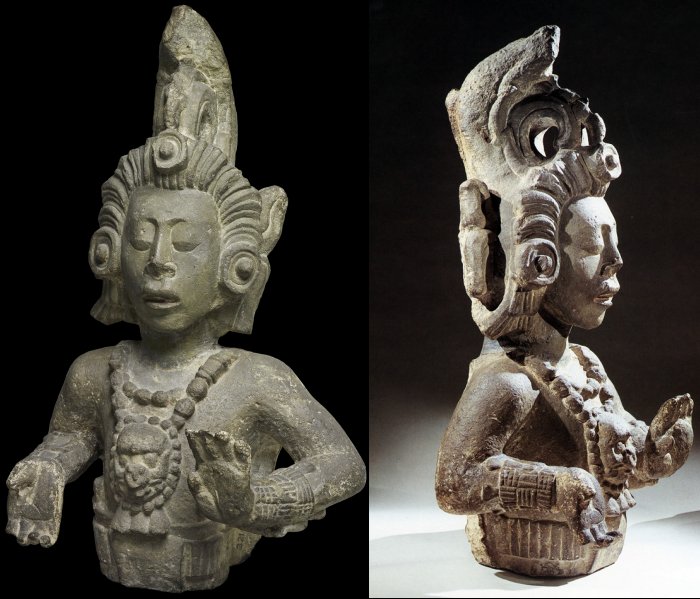 Maize god, Temple 22, Copan. source
Maize god, Temple 22, Copan. source
In his anger, the Lord sent the baby away to be sacrificed. After his brothers cast the young child into a mountain, the baby jaguar was reborn as the Maize god. It is said that he sprang back into life through the seed of the maize plant.
Maize God With Jade Ornaments
It is most likely that the Maize god became so popular that the Mayan people depended a lot on maize for their dietary needs. In fact, there are over 40 types of Mayan or Mesoamerican maize agriculture forms.
This importance, even though he was not a lead god, is indicated by the inclusion of the maize god’s death and rebirth on a Mayan ruler’s sarcophagus lid. Discovered in 1949, this lid shows the Mayan ruler Pakal being born of a maize seed.
Also, the Maize god is always depicted as a young person with jade ornaments. Jade was part of the rebirth process of the Maize god. This depiction symbolized fertility, beauty, and jade.
It is possible that the Mayan people looked to the Maize god for those things that almost every member of every society wanted- long life, beauty, and wealth.
Maize God And El Mirador
One of the problems with tying the Maize god to El Mirador is that the different Mayan cities did not always worship the same gods. If they did, they often changed the name of the god to suit their beliefs at that time.
Yet, at the same time, the Mayans did recognize all their gods on a universal scale. In other words, while they did not worship the particular god by the same name, if at all, they still accepted them as a Mayan god.
Another difficulty is that it appears that the Maize god did not have his temple or house of worship. With the lack of knowledge concerning the Mayan language, pointing to a pyramid or some other abandoned Mayan structure, such as the Maize god temple, would be challenging.
With all their human sacrifices, the Mayans worshiped all their gods at the same pyramids.
Written by – David Tee AncientPages.com Staff Writer
Updated on Oct 16, 2023
Copyright © AncientPages.com All rights reserved. This material may not be published, broadcast, rewritten or redistributed in whole or part without the express written permission of AncientPages.com
More From Ancient Pages
-
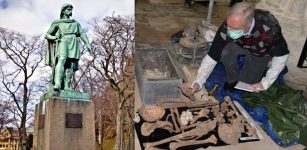 Mystery Of Viking Ruler Rollo Continues – Surprising Discovery In Ancient Grave
Archaeology | Jan 22, 2017
Mystery Of Viking Ruler Rollo Continues – Surprising Discovery In Ancient Grave
Archaeology | Jan 22, 2017 -
 Pryor Mountains Are Home To The Mysterious Little People – Native Americans Say
Featured Stories | Aug 2, 2021
Pryor Mountains Are Home To The Mysterious Little People – Native Americans Say
Featured Stories | Aug 2, 2021 -
 Likho (Licho): Puzzling And Persistent Demon Of Mischief In Slavic Mythology
Featured Stories | Dec 18, 2016
Likho (Licho): Puzzling And Persistent Demon Of Mischief In Slavic Mythology
Featured Stories | Dec 18, 2016 -
 Cambridge Supports Nigeria’s Claim For Return Of Benin Artefacts From University Collections
Archaeology | Aug 2, 2022
Cambridge Supports Nigeria’s Claim For Return Of Benin Artefacts From University Collections
Archaeology | Aug 2, 2022 -
 What Was Legio Martia And Why Were The Roman Soldiers Called The Martians?
Ancient History Facts | Jan 5, 2018
What Was Legio Martia And Why Were The Roman Soldiers Called The Martians?
Ancient History Facts | Jan 5, 2018 -
 Roman Ship Cargo And Galley Equipment Discovered Underwater In The Caesarea Harbor
Archaeology | Sep 12, 2023
Roman Ship Cargo And Galley Equipment Discovered Underwater In The Caesarea Harbor
Archaeology | Sep 12, 2023 -
 Paleoindian Ochre Mine Found In Submerged Caves In Mexico’s Yucatan Peninsula
Archaeology | Jul 6, 2020
Paleoindian Ochre Mine Found In Submerged Caves In Mexico’s Yucatan Peninsula
Archaeology | Jul 6, 2020 -
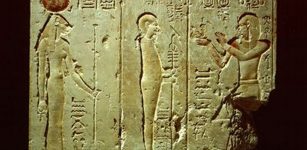 Egyptian Temple Culture In Ptolemaic-Era Survived Changes And Became Even Stronger – Researcher Says
Archaeology | Mar 1, 2017
Egyptian Temple Culture In Ptolemaic-Era Survived Changes And Became Even Stronger – Researcher Says
Archaeology | Mar 1, 2017 -
 Ancient Mesopotamian Discovery Changes Our Understanding Of Early Agriculture Practices
Archaeology | Jan 17, 2022
Ancient Mesopotamian Discovery Changes Our Understanding Of Early Agriculture Practices
Archaeology | Jan 17, 2022 -
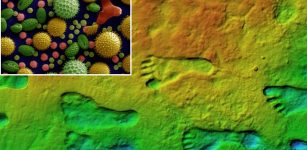 Humans Got To America 7,000 Years Earlier Than Thought – New Research Confirms
Archaeology | Oct 9, 2023
Humans Got To America 7,000 Years Earlier Than Thought – New Research Confirms
Archaeology | Oct 9, 2023 -
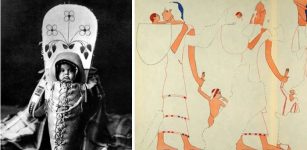 Baby Carriers Were Used 10,000 Years Ago – New Evidence
Archaeology | Sep 27, 2022
Baby Carriers Were Used 10,000 Years Ago – New Evidence
Archaeology | Sep 27, 2022 -
 Nilometer: Innovative Tool Measuring The Nile’s Water Levels In Pharaonic Egypt
Featured Stories | Jun 1, 2024
Nilometer: Innovative Tool Measuring The Nile’s Water Levels In Pharaonic Egypt
Featured Stories | Jun 1, 2024 -
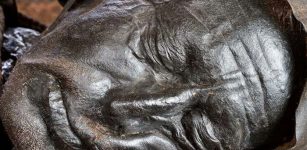 Mystery Of Europe’s Bog Body Phenomenon Solved By Scientists
Archaeology | Jan 12, 2023
Mystery Of Europe’s Bog Body Phenomenon Solved By Scientists
Archaeology | Jan 12, 2023 -
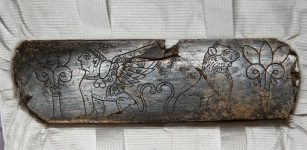 Unique 2,800-Year-Old Ivory Object Unearthed At Hattusa
Archaeology | Nov 14, 2023
Unique 2,800-Year-Old Ivory Object Unearthed At Hattusa
Archaeology | Nov 14, 2023 -
 Ancient Manuscript Reveals: Jesus Was Married And Fathered Two Children With Mary Magdalene
Archaeology | Nov 10, 2014
Ancient Manuscript Reveals: Jesus Was Married And Fathered Two Children With Mary Magdalene
Archaeology | Nov 10, 2014 -
 Secret Catacombs With Incredible Ancient Skeletons Covered In Priceless Jewelry
Featured Stories | Nov 20, 2018
Secret Catacombs With Incredible Ancient Skeletons Covered In Priceless Jewelry
Featured Stories | Nov 20, 2018 -
 Archaic Hominins Began Sea-Crossings The Aegean Sea 450,000 Years Ago
Archaeology | Dec 22, 2022
Archaic Hominins Began Sea-Crossings The Aegean Sea 450,000 Years Ago
Archaeology | Dec 22, 2022 -
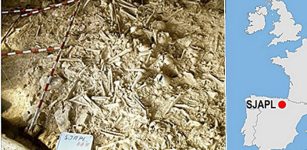 Earliest Period Of Warfare In Europe Occurred Over 1,000 Years Earlier Than We Thought
Archaeology | Nov 3, 2023
Earliest Period Of Warfare In Europe Occurred Over 1,000 Years Earlier Than We Thought
Archaeology | Nov 3, 2023 -
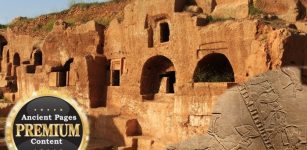 Mysterious Ancient Tomb May Contain Remains Of A Powerful Forgotten Goddess
Civilizations | Aug 30, 2018
Mysterious Ancient Tomb May Contain Remains Of A Powerful Forgotten Goddess
Civilizations | Aug 30, 2018 -
 Evidence Of Ancient Gigantic Tsunami That Struck Tel Dor Maritime City Mound, Israel
News | Jan 1, 2021
Evidence Of Ancient Gigantic Tsunami That Struck Tel Dor Maritime City Mound, Israel
News | Jan 1, 2021
